Gaming has revolutionized with the advent of immersive visual experiences, and a notable part of this evolution is the introduction of curved gaming monitors. These technological marvels, with their engaging design and state-of-the-art specifications, have reshaped the way gamers interact with their digital universes. Our exploration into the world of curved gaming monitors encompasses an understanding of their design, principles, and technical specifics. Furthermore, a balanced viewpoint weighing pros against potential cons, coupled with market insights and compatibility concerns, will equip readers with a comprehensive knowledge base, enabling a well-informed decision when embarking upon the quest for the ultimate gaming experience.
Overview of Curved Gaming Monitors
Leaders in the tech world know it’s a constant hustle to stay on top of the latest and greatest hardware. As we surge forth in this ever-evolving landscape, one piece of technology has caught our eye: curved gaming monitors. But what, exactly, sets these newfangled screens apart from their traditional, flat counterparts? That’s what we’re about to delve deep into.
First off, immersion is the name of the game. Curved gaming monitors offer an immersive gaming experience that flat monitors can’t compete with. When gaming on a curved monitor, the display wraps around your field of view, pulling you right into the action. You are not merely observing – you’re participating.
Let’s talk about a significant technical advantage: consistent visual quality. With flat monitors, the distance from the screen to your eyes varies as you look from the center of the screen to the edges. This causes distortion and colour shifts. On the other hand, curved monitors maintain an equal distance across the entirety of the screen, offering a more uniform viewing experience.
One more point to discuss is comfort. We might overlook this factor until confronted with those pesky headaches and eyestrain. The concave shape of a curved monitor matches our eyes’ natural curvature, letting us take in more information at once. This reduces the need to shift our focus and strain to see what’s at the edges, resulting in less strain and more comfort.
Do your gaming ambitions lead towards competitive play? Well, a curved monitor could be your secret weapon. We’re not promising it’ll transform you into a pro overnight, but it could offer the marginal gain you seek. Curved monitors provide a wider field of view with no distortion, which can be the difference-maker in fast-paced, competitive games.
But, a reality check is necessary. A curved gaming monitor isn’t perfect or universally superior. Like any other technology item, it’s all about user preferences and specific needs. For instance, while curved monitors take gaming to new heights, they are not ideal for graphic designing work where fine lines and perfect shapes are necessary.
Regardless, the impact of curved gaming monitors cannot be understated. They have indeed made a deep imprint in the gaming world with their immersive, high-quality visuals and comfort-oriented design. These monitors hold the potential to make every gaming session not just more enjoyable, but also more productive and less straining.
Though there’s always plenty of hype involved when new tech hits the market, it’s safe to say that in the case of curved gaming monitors, the hype is well-justified. If gaming is your passion and you’re willing to venture beyond the conventional, it might be time to make that leap to curved gaming monitors. This could be the game-changer you were waiting for.
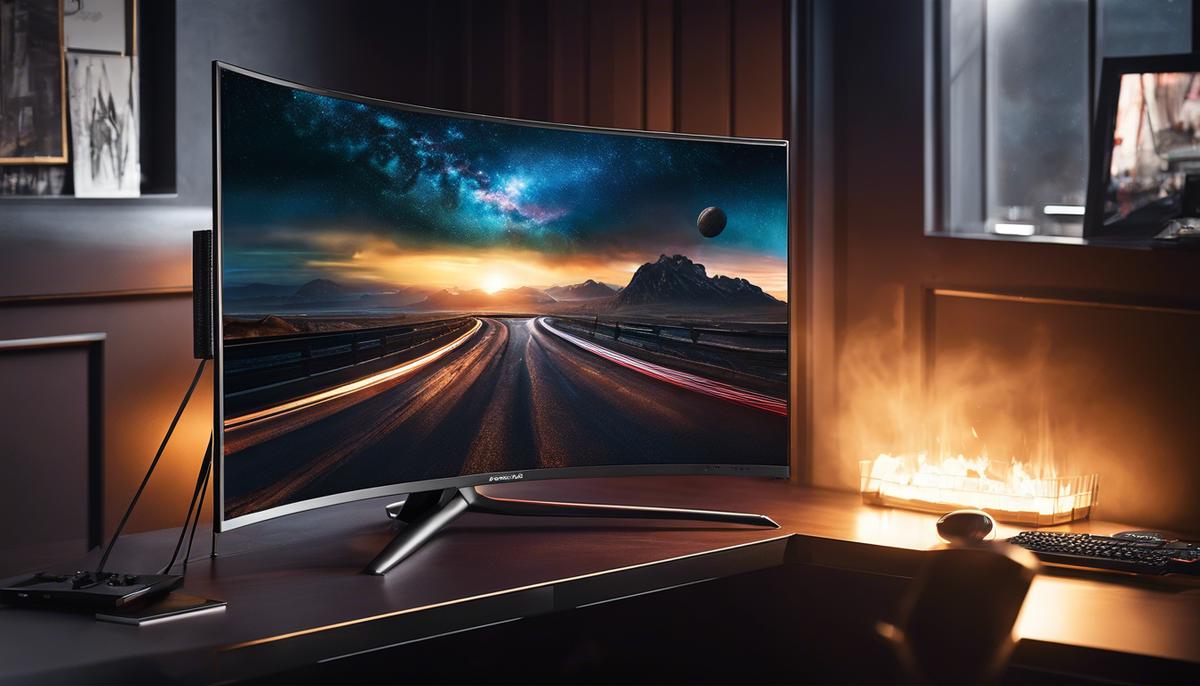
Technical Specifications of Curved Gaming Monitors
When we delve deeper into the topic of selecting the right curved gaming monitor, the importance of technical specifications cannot be overstressed. Certain specifications make a significant contribution to the overall gaming experience and should be given priority when assessing different monitor options.
Refresh rate, measured in hertz (Hz), is at the top of the list when it comes to specifications. It corresponds to the number of times per second that the monitor can update with new information. Higher refresh rates, such as 120Hz or 144Hz, offer smoother and more fluid gameplay, and are particularly valuable for fast-paced, competitive games where every millisecond can make a difference.
In tandem with refresh rate, you should consider the monitor’s response time. This is the speed at which each pixel can change colors and is measured in milliseconds (ms). Lower response times (1ms-5ms) result in minimal motion blur and ghosting effects, contributing to a sharper and more focused image.
Resolution attributes to the number of horizontal and vertical pixels on a monitor. Generally, higher resolution monitors, such as those delivering 1440p or 4K, provide sharper and more detailed images. However, keep in mind that running games at higher resolutions requires significantly more computational power from your PC.
Panel technology is another critical specification. There are three main types: Twisted Nematic (TN), In-Plane Switching (IPS), and Vertical Alignment (VA). Each offers a different balance of color accuracy, response time, and viewing angles. IPS panels tend to deliver superior color reproduction and wider viewing angles, making them an attractive choice for immersive gaming experiences.
Size is another crucial specification. While the best size ultimately depends on personal preference and available space, a larger monitor can enhance the immersive feel of curved displays. That being said, don’t forget that increasing monitor size without adjusting the resolution can negatively affect image quality.
Aspect ratio, which represents the width of the screen relative to its height, is worth paying attention to. A wide aspect ratio (e.g., 21:9 or 32:9) can provide a broader field of view than the traditional 16:9 ratio, further augmenting the immersion factor of curved gaming monitors.
Finally, inspect the monitor’s Adaptive Sync technology. NVIDIA’s G-Sync and AMD’s FreeSync technologies synchronize the monitor’s refresh rate with the graphics card’s frame rate output, reducing tearing and stuttering.
These key technical specifications play a massive role in your final gaming experience. While the immersive experience and consistent visual quality offered by curved gaming monitors are commendable, the monitor’s performance ultimately hinges on these technicalities. Therefore, combine your user preferences with these specifications to pinpoint your optimal curved gaming monitor. Although identifying these can seem a bit daunting, the payoff of your effort, in the form of an impressive in-game performance, is definitely worth the initial hustle.
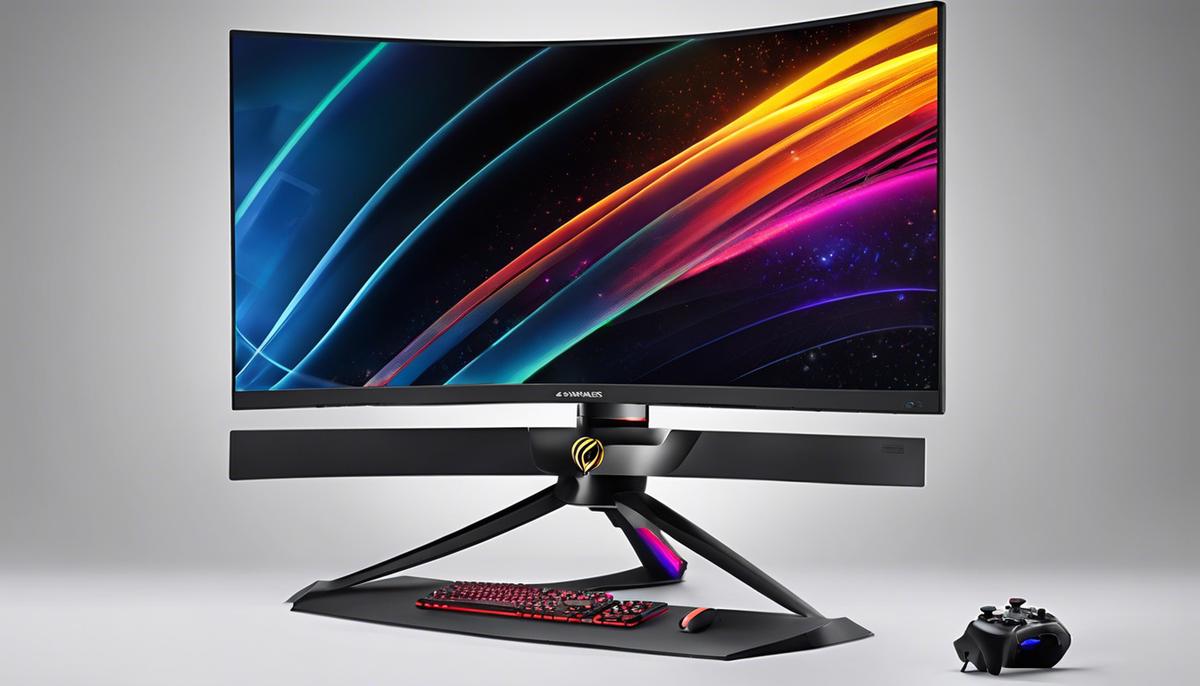
Benefits and Drawbacks of Curved Gaming Monitors
Curved gaming monitors, just like any technology, come with their own set of merits and demerits. While the immersive gaming experience, consistent visual quality, comfort benefits, and advantage in competitive gaming they present have been discussed, it’s essential to dig a bit deeper.
One significant aspect to consider is the refresh rate. Curved monitors often have high refresh rates, which can provide smoother visuals and less motion blur during high-speed gaming scenarios. This can give a competitive edge to gamers. However, keep in mind that a higher refresh rate often comes with a higher price tag. Plus, to take full advantage of this feature, one’s PC must be capable of producing enough frames per second, which might require a significant investment in PC hardware.
Response time is another vital factor. Lower response times can reduce ghosting and create clearer images during fast-paced scenes. Curved gaming monitors can excel here, but the degree of improvement can vary based on the specific model and panel technology.
Speaking of panel technology, there are three types to consider: TN (Twisted Nematic), IPS (In-Plane Switching), and VA (Vertical Alignment). TN panels can offer high refresh rates and response times, but might underperform in color accuracy and viewing angles. In contrast, IPS panels can present more accurate colors and broader viewing angles, but may not match the response times or refresh rates of TN panels. Meanwhile, VA panels tend to land somewhere in the middle, offering good contrast and color depth, though often at the expense of response time. Given the shape of curved monitors, investing in an IPS or VA panel can be a wise choice, due to their better viewing angles.
On the size front, bigger is not always better. Larger monitors do provide a more immersive experience, but they can also be cumbersome and require more desk space. Additionally, a larger monitor could lead to more noticeable pixelation unless it comes with a corresponding increase in resolution.
Aspect ratio is another crucial consideration. The ultra-wide aspect ratio (21:9) seen on many curved monitors can offer a significant increase of horizontal workspace compared to traditional 16:9 monitors, which is great for multitasking and widescreen media. But this can also result in compatibility issues with some games which don’t support ultra-wide resolutions.
Finally, the Adaptive Sync technology (G-Sync for Nvidia GPUs, and FreeSync for AMD) is used in curved monitors to prevent screen tearing and stuttering. This gives you smoother gameplay but it’s essential to ensure the selected monitor’s Adaptive Sync technology is compatible with your GPU.
In conclusion, curved gaming monitors offer potential advantages like immersiveness, comfort, and good visual quality, but several aspects like refresh rate, response time, panel technology, size, aspect ratio, and Adaptive Sync technology need to be taken into consideration. It all boils down to one’s individual preferences, needs, and budget.
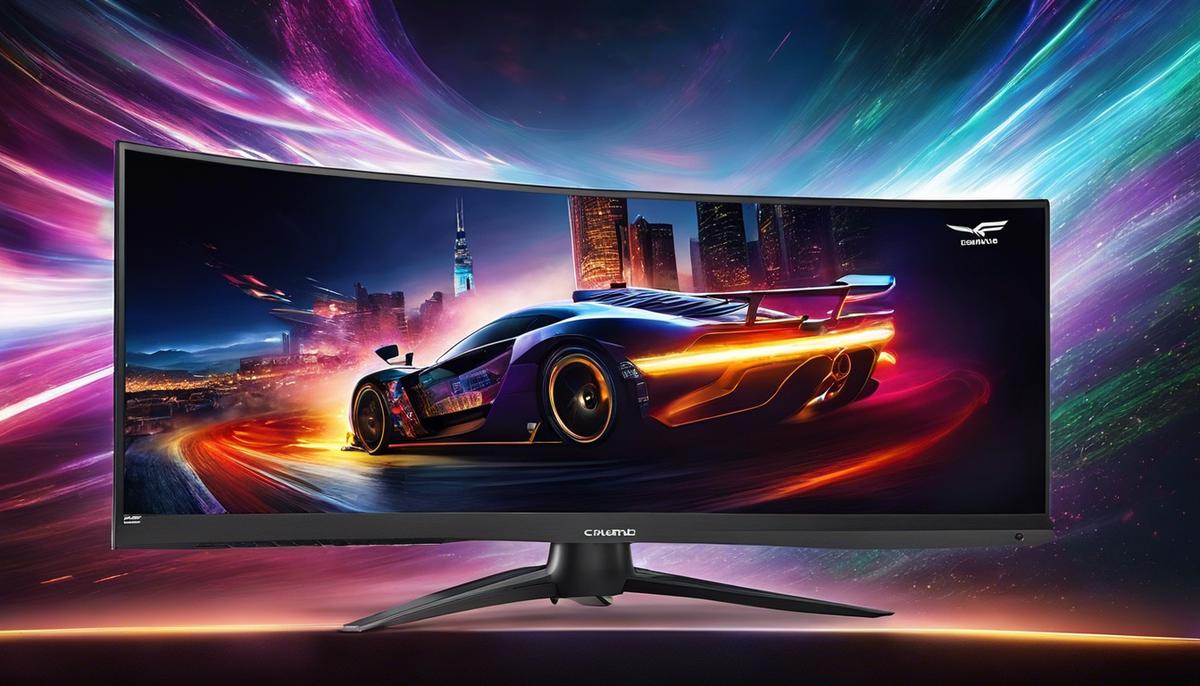
Market Trends and Top Players in Curved Gaming Monitors
Curved gaming monitors are more than just a fad, they’re spearheading the cutting edge of immersive, comfortable, and efficient gaming technology. With various top brands battling it out for dominance of this growing market, it’s clear that curved gaming monitors are here to stay. That said, players could also stand to understand the current trends defining the curved gaming monitor space.
Kicking things off, is the escalating competition between renowned tech giants. Samsung, Acer, ASUS, LG and Dell are making significant investments in their curved gaming monitors, making for a diverse and innovative market landscape. Each brand brings a unique take to the table – whether it’s Samsung’s Quantum Dot technology for dazzling colors and contrasts, Acer’s aggressive curve and lightning fast refresh rate, or ASUS’s impeccable attention to ultra-wide resolutions and high-end aesthetics.
But it’s not just about the big names. Emerging brands like AOC and MSI have made substantial strides and are steadily earning gamer’s trust with their affordable yet feature-packed monitors. Bigger isn’t always better, and these disruptors prove that innovation comes in all sizes.
Turning the spotlight onto trends, one can’t overlook the rapidly progressing monitor specifications. For instance, ever-increasing refresh rates are now commonplace, going as high as 240Hz, and even hitting 360Hz among top models for ultra smooth visual output. The tether between refresh rates and response times is also tightening as gaming monitors now boast sub-1ms grey-to-grey response times which significantly reduces ghosting and promotes clearer images.
Furthermore, the growing preference for high-resolution gaming has paved the way for 1440p and 2160p (4K) curved gaming monitors. Paired with expansive color gamuts and HDR support, these monitors offer a gaming experience that’s truly next-level.
If it’s immersive gaming you crave, then the wider 21:9 aspect ratio is now definitive. Some models even push boundaries further to 32:9 ratios, but with more immersive viewing come potential issues, like compatibility with certain games and higher demands on your GPU.
Technically speaking, panel technology has been seeing heaps of innovation too. IPS panels are coming out on top due to their superior color accuracy and viewing angles, though TN and VA panels certainly retain their niches.
Lastly, no examination of current trends would be complete without mention of Adaptive Sync technologies, specifically Nvidia’s G-Sync and AMD’s FreeSync. They’ve matured, become more efficient and are now vital components in preventing screen tearing and stuttering for the smoothest possible gameplay.
Choices are numerous, and while it’s a boon for tech-enthusiasts, it can also cause some confusion. There’s no one-size-fits-all answer so preferences, needs, and budget should drive your selection. Whether you’re a casual or a competitive gamer, the curved gaming monitor market is primed to cater to your desires – you just need to navigate this technological labyrinth to discover your perfect match.
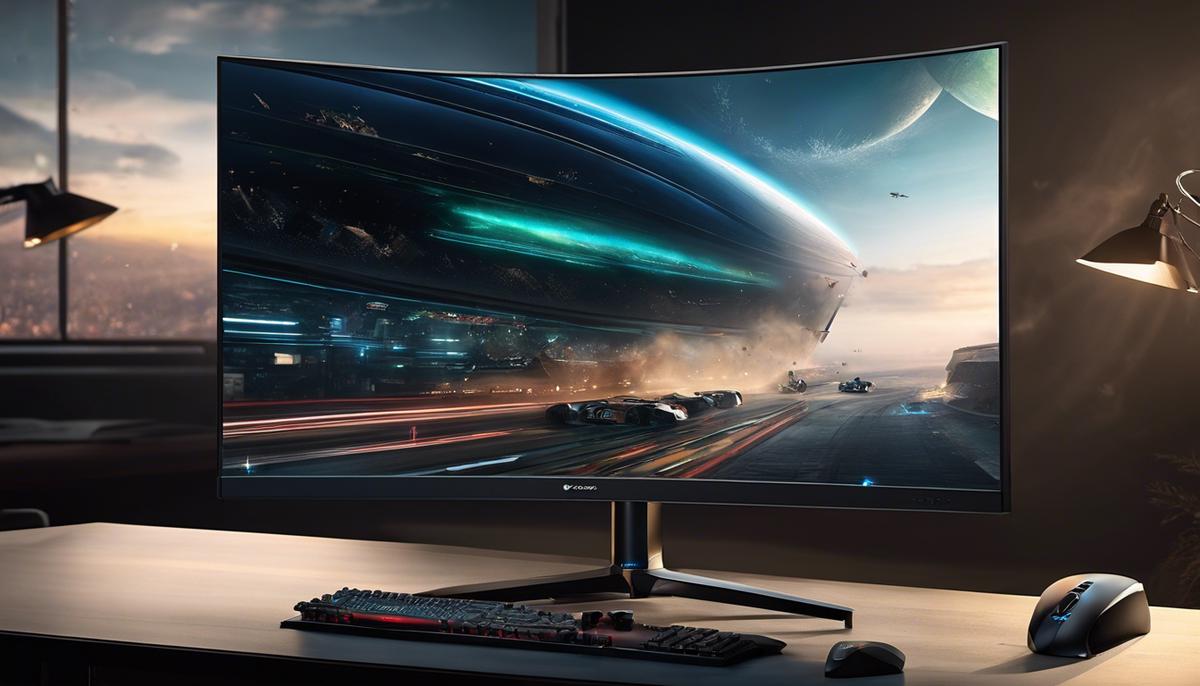
Integration and Compatibility Concerns
Embracing a curved gaming monitor undoubtedly revolutionizes the gaming experience significantly. However, the integration process is not always a bed of roses. With tech advancements come challenges, and curved gaming monitors are no exception. This is all about envisaging and addressing potential compatibility issues while merging curved monitors into your gaming setup.
A fundamental compatibility issue revolves around the graphics processing unit (GPU). For the uninitiated, the GPU significantly impacts the performance of a monitor. For a seamless interaction between your curved monitor and GPU, ensure they are fully compatible. A mismatch could lead to unfavorable phenomena such as screen tearing and stuttering. Curved monitors with Adaptive Sync technologies like Nvidia’s G-Sync and AMD’s FreeSync liaise with the GPU to enhance smoothness and minimize inconveniences like tearing.
The quest for larger screens and the push for an immersive experience could initiate another challenge – the space aspect. An ultra-wide curved gaming monitor might overwhelm some workstations, leading to clutter and discomfort. Integrate your setup wisely, considering the monitor’s size, your space, and the need for other peripherals.
Aspect ratio, a vital determinant of your gaming experience, is another potential challenge you might encounter. Most curved gaming monitors offer 21:9 or 32:9 aspect ratios for immersive gaming. Nevertheless, not all games or applications support these ultra-wide aspect ratios. In such instances, the image stretches or black bars appear on the sides — not a pretty sight. Before making that purchase, reflect on the games you plan to run and their compatibility with your monitor’s aspect ratio.
Another pronounced concern arises from different panel technologies. TN, IPS, and VA panels, all come with distinct advantages and drawbacks, affecting performance, color accuracy, viewing angles, and more. Your usage pattern and gaming preferences come into play here. A TN panel might provide faster response times, holding appeal for competitive gamers, while an IPS or VA panel offering superior color accuracy and viewing angles could be more appealing to graphic designers or casual gamers.
There’s also the looming issue of competing brands such as Samsung, Acer, ASUS, LG, and Dell. Each brand has unique features, like Samsung’s Quantum Dot technology or Acer’s aggressive curve and fast refresh rate. Emerging brands, like AOC and MSI, are also stirring up the market with their offerings. It would be best if you navigated these waves wisely to avoid compatibility issues with previous parts of your setup or missing out on features that matter to you.
Resolution is the icing on the cake providing crisp, vivid images. As the preference for high-resolution gaming (1440p, 2160p) grows, your GPU’s power needs to match up. High-resolution gaming demands more GPU resources. Before jumping on that high-res curved monitor, ascertain that your GPU can handle it.
In conclusion, curved monitors herald immersive gaming, but some issues need attention. Knowing your needs, being conversant with the challenges, and ensuring compatibility with your existing setup are fundamental steps to integrating a curved monitor smoothly into your gaming adventure.
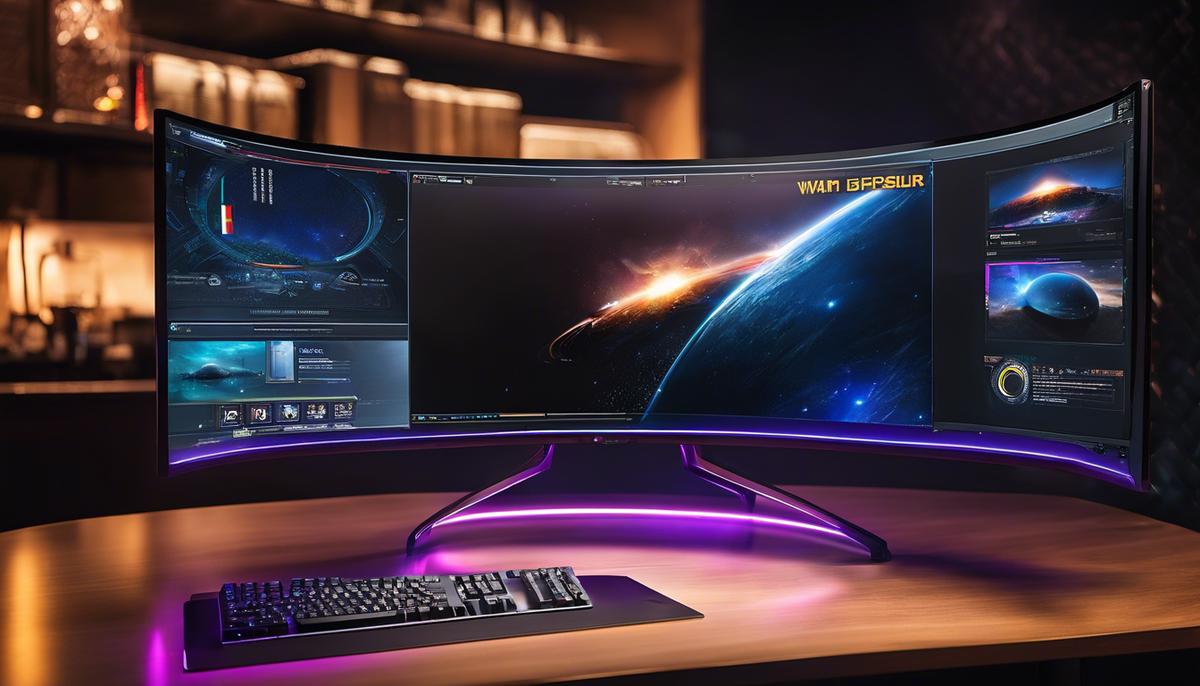
Curved gaming monitors, with their all-encompassing visuals and futuristic design, are undeniably a captivating addition to the realm of gaming. However, similar to all technological advancements, they bring along a spectrum of aspects to consider, ranging from technical specifications to compatibility concerns. As the market brims with offerings from numerous industry leaders, making an informed choice can be a daunting task. Yet, a comprehensive understanding of the functionalities, an exploration of key market trends, and a knowledge of potential pitfalls can surely guide one towards making a decision that optimizes their gaming experience to the fullest. Remember, the ultimate aim is to enhance your gaming journey’s enjoyment, immersion, and comfort.




